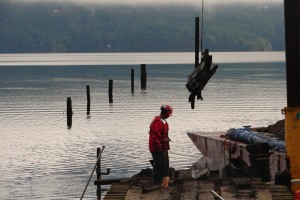from FRIENDS of the San Juans

DNR contractors remove a derelict dock and creosote-treated pilings from Judd Cove, Orcas Island. Photo by Lisa Kaufman, DNR.
FRIENDS of the San Juans is partnering with the Washington State Department of Natural Resources (DNR) to remove unnecessary toxic creosote-treated pilings and old structures from tidelands in San Juan County at no cost to interested landowners. The goal of the project is to improve water quality and overall ecosystem health for salmon and salmon prey.
Creosote-treated wood was commonly used in marine structures throughout the Salish Sea for more than a century during a period of rapid development and industrial expansion. Like other chemical compounds that were innovations in their time, creosote was broadly used without knowledge of its long-term consequences. It is now known that creosote contains more than 50 carcinogens and is toxic to marine fish and other wildlife.
“Research has shown that herring eggs exposed to creosote have a high mortality rate,” said Tina Whitman, FRIENDS’ Science Director. “Chemicals found in creosote also affect juvenile salmon that migrate through contaminated estuaries by reducing their growth and altering immune function. These chemicals also affect other species, such as herring, that are important food for salmon, Orca and birds.”
DNR has been partnering with local groups, governments, and private property owners to remove treated wood located on public and private property throughout the Salish Sea since 2004.
“We look forward to collaborating with FRIENDS and San Juan County citizens to restore and protect beaches and tidelands from the continuing negative effects of creosote treated wood in the marine environment,” said Lisa Kaufman, DNR Restoration Manager.
FRIENDS and DNR are currently seeking property owners who have in-water creosote-treated pilings they are interested removing. This program is voluntary and free to property owners. To participate, contact Tina Whitman (FRIENDS) at 360-378-2319 or Lisa Kaufman (DNR) at 360-854-2808.
The focus of this project is the removal of unwanted in-water piles and structures. However, FRIENDS and DNR are also interested in hearing about beach sites with large accumulations of creosote-treated debris that wash up on shore. This material may eligible for removal through DNR’s Puget SoundCorps Program.
FRIENDS received funding from the Washington State Salmon Recovery Funding Board to coordinate the local effort in San Juan County. This is part of the state-wide DNR Creosote Removal Program in which more than 13,400 tons of piles, 231,000 square feet of overwater structures and 2,700 tons of toxic beach debris have been removed from the Salish Sea to date.
**If you are reading theOrcasonian for free, thank your fellow islanders. If you would like to support theOrcasonian CLICK HERE to set your modestly-priced, voluntary subscription. Otherwise, no worries; we’re happy to share with you.**







